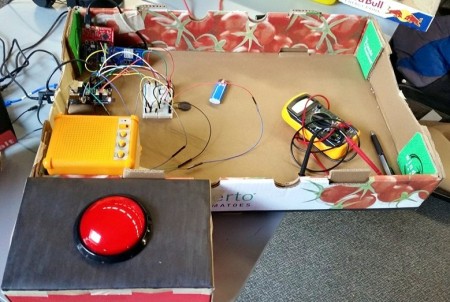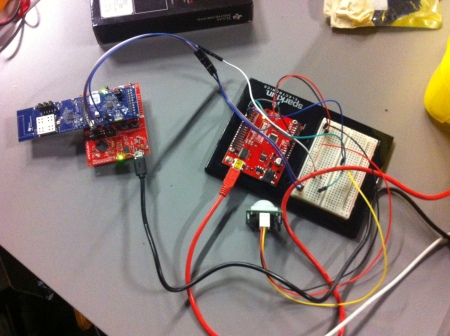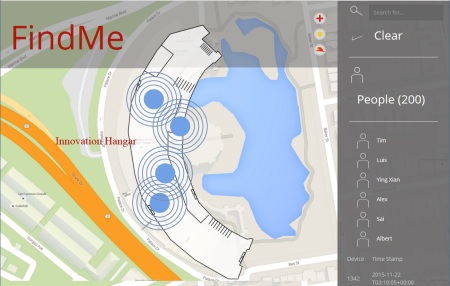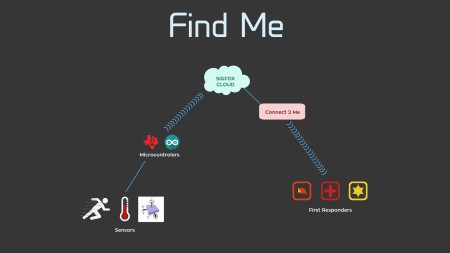I attended the Connect your City hackathon organized by Sigfox and the city of San Francisco. It was absolute fun.
What is Sigfox?
Sigfox is a European company that has installed low power wide area networks across several cities in Europe and San Francisco. Sigfox’s radio network enables interfacing low power sensors to a network enabled by radio transceivers installed in San Francisco’s public libraries.
This radio network enables transmitting a 12 byte message at a time and it is capped at 140 messages per day. This network is very useful in the case of interfacing sensors that do not provide real time updated. For example. sensors that report their status every hour or so, panic buttons that transmit emergency alerts to first responders etc.
The Hackathon
In the hackathon, teams were given the Texas Instruments Sigfox boosterpack, access to the Sigfox backend, assistance from Microsoft’s Azure team and Plasma/Connect2me. The hackathon’s objective was to build proof-of-concepts that would have a civic impact in the city of San Francisco.
My team’s project
My team picked a project that enabled collecting information related to the number of people assembled in any room of a building. This information is transmitted to the Sigfox network in the event of an earthquake (detected by an accelerometer installed in the building) or whenever a panic button is pressed.
We also used a PIR sensor, temperature sensor and a force detecting sensor to simulate events like large pillar columns falling down, buildings catching fire etc. This information could be used by first responders to effectively deploy resources in an emergency.
We built two gadgets. I built one of them and is shown in the figure below. It includes a panic button, temperature sensor and a force detecting sensor.

Gadget that I built includes panic button, temperature and force sensors
My team mate Yingxian built another radio that gathered information from an accelerometer and a PIR sensor.

Photo Courtesy: Yingxian Wang
The radios transmitted the messages to the Sigfox radio network. The transmitted messages were supposed to be used for visualization in a web dashboard like the one shown below.

Dashboard by Tim Strickland
How does this gadget work?
The figure below provides a simple description of how these radios interact with the “cloud”.

We got an unlimited evaluation license for our radios and our radios did not have any daily cap on the number of messages that could be transmitted to the network for development purposes.
The radios were very easy to use. They transmit any message received through the serial port. We used an Arduino Yun to interface our sensors. The Arduino Yun transmits the message to the radio via serial port. It also talks to a processor running linux on the Arduino Yun. Here is a short video of my project: It sends an emergency alert to the Sigfox network and plays an audio alert.
Here is another video where we simulated an earthquake. My teammate, Yingxian wrote the code to detect earthquake like movements to detect earthquake simulations using an accelerometer.
My team
I met my team mates at the hackathon and I am amazed by how we were able to get along with each other. Here is a pic of my team after the hackathon prizes were announced.

Left to Right: Yingxian, me, Tim, Louis, Albert and Alex.
Who were the winners?
AudioArgus – A team that built a service that predicts faulty rotary/reciprocating equipment requiring service and alerts the city about it. I see this as a project that enforces behavior change using the Internet of Things.
Dry Water – A water sprinkler controller project that considers several weather factors to turn on/off a sprinkler. I see this one also a behavior change tool by building connected devices
There was also a bike project that enabled enhancement of bike rental experience. I am not sure that I am able to recall the project’s theme correctly.
- The radio network’s coverage spans between parts of San Bruno in the San Francisco Bay peninsula, Hayward in the eastern side of the Bay, parts of Marin County and Berkeley.
- The sketch used to transmit messages is available from here.
What next?
I had fun working on this project last weekend. This has motivated me to register for another smart city hackathon on December 5th. If you are interested in working on a similar project (not the same one) at that hackathon, you should write to me @ yamanoorsaiatgmaildotcom or ping me via twitter using the same handle.



 Posted by yamanoorsai
Posted by yamanoorsai 
